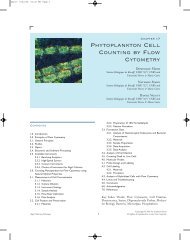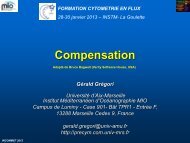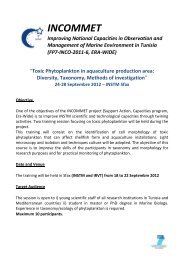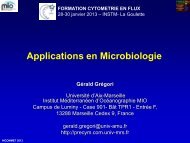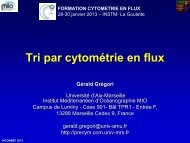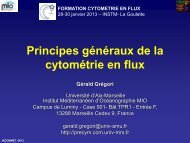Eukaryotic Picoplankton in Surface Oceans - incommet
Eukaryotic Picoplankton in Surface Oceans - incommet
Eukaryotic Picoplankton in Surface Oceans - incommet
Create successful ePaper yourself
Turn your PDF publications into a flip-book with our unique Google optimized e-Paper software.
Annu. Rev. Microbiol. 2011.65:91-110. Downloaded from www.annualreviews.org<br />
by CSIC - Consejo Superior de Investigaciones Cientificas on 09/27/11. For personal use only.<br />
<strong>Eukaryotic</strong><br />
supergroups: major<br />
l<strong>in</strong>eages of eukaryotes<br />
that jo<strong>in</strong> together<br />
apparently unrelated<br />
taxonomic groups on<br />
the basis of<br />
ultrastructural and<br />
molecular data<br />
CCTH: cryptophytes,<br />
centrohelids,<br />
telonemids, plus<br />
haptophytes<br />
MALV: mar<strong>in</strong>e<br />
alveolates<br />
the large database of mar<strong>in</strong>e metagenomes<br />
from the Global Ocean Sampl<strong>in</strong>g expedition<br />
(69) is fuel<strong>in</strong>g the microbial research agenda.<br />
These approaches still need to focus specifically<br />
on picoeukaryotes, which are often removed<br />
by filtration from the analysis.<br />
Comb<strong>in</strong><strong>in</strong>g techniques gives further functional<br />
<strong>in</strong>sights <strong>in</strong>to uncultured cells. A general<br />
approach is to <strong>in</strong>cubate natural assemblages<br />
with a labeled precursor and identify the<br />
taxa <strong>in</strong>corporat<strong>in</strong>g it. The precursor can be<br />
radioactive <strong>in</strong>organic or organic carbon for<br />
phototrophy or osmotrophy, or labeled bacteria<br />
for graz<strong>in</strong>g. Cells <strong>in</strong>corporat<strong>in</strong>g radioactive<br />
substrates can be seen by microautoradiography<br />
and FISH (83). Flow cytometry can be<br />
used to sort populations before assess<strong>in</strong>g their<br />
radioactivity and community structure (36).<br />
Grazers with <strong>in</strong>gested fluorescent bacteria can<br />
be seen by FISH (57), whereas those <strong>in</strong>gest<strong>in</strong>g<br />
isotopically labeled bacteria can be identified<br />
by sequenc<strong>in</strong>g labeled rRNA separated by<br />
ultrafiltration (28). The sort<strong>in</strong>g capacities of<br />
modern flow cytometers are open<strong>in</strong>g new<br />
possibilities for s<strong>in</strong>gle-cell analyses. S<strong>in</strong>gle<br />
microbial cells can be used as <strong>in</strong>ocula to start<br />
pure cultures or as template for whole genomic<br />
amplification prior to genome sequenc<strong>in</strong>g.<br />
This s<strong>in</strong>gle-cell approach has been recently<br />
applied to heterotrophic flagellates (33).<br />
NAVIGATING THROUGH THE<br />
MAIN PHYLOGENETIC GROUPS<br />
In the past decade, advanced multigene phylogenies<br />
have del<strong>in</strong>eated the eukaryotic tree of<br />
life <strong>in</strong>to a few eukaryotic supergroups, each<br />
one <strong>in</strong>clud<strong>in</strong>g well-known taxonomic classes<br />
(6, 9). Although the configuration of supergroups<br />
varies, the general consensus <strong>in</strong>cludes<br />
unikonts (opisthokonts plus amoebozoans), archaeplastidans,<br />
SAR (stramenopiles, alveolates<br />
plus rhizarians), excavates, and CCTH (cryptophytes,<br />
centrohelids, telonemids plus haptophytes).<br />
<strong>Eukaryotic</strong> molecular surveys use this<br />
renovated tree of life as the phylogenetic frame<br />
to place environmental sequences (20, 50, 55,<br />
58, 82). To present the phylogenetic groups<br />
detected, I use a dataset of 8,719 public 18S<br />
rDNA sequences (V4-V5 regions) mostly from<br />
surface picoeukaryotes, but also from deep sea<br />
and larger protists (Figure 4). The clonal representation<br />
of each group (roughly equivalent to a<br />
class) gives an <strong>in</strong>itial taste of its importance but<br />
is also <strong>in</strong>fluenced by the variable rDNA copy<br />
number among taxa and other molecular biases.<br />
So, when available, additional data based on<br />
pigments, FISH, metagenomics, or other gene<br />
markers are added for each group. This section<br />
ends with an overview of the ma<strong>in</strong> phylogenetic<br />
groups compris<strong>in</strong>g mar<strong>in</strong>e picoeukaryote<br />
assemblages.<br />
Alveolates: MALV<br />
This supergroup <strong>in</strong>cludes d<strong>in</strong>oflagellates,<br />
ciliates, apicomplexans, and MALV (mar<strong>in</strong>e<br />
alveolates) (31) and dom<strong>in</strong>ates mar<strong>in</strong>e<br />
eukaryote surveys with 57% of sequences<br />
(Figure 4b). D<strong>in</strong>oflagellates and ciliates<br />
are well-known free-liv<strong>in</strong>g heterotrophs,<br />
mixotrophs, or phototrophs and are well<br />
represented (11% of sequences each). They<br />
still comprise 5% of sequences <strong>in</strong> a dataset<br />
of only picoeukaryotes (Figure 4c), which is<br />
surpris<strong>in</strong>g because their known m<strong>in</strong>imal size<br />
is 5 to 10 μm. The existence of picosized<br />
d<strong>in</strong>oflagellates or ciliates is possible, but the<br />
most plausible explanation is a comb<strong>in</strong>ation<br />
of filtration artifacts and amplify<strong>in</strong>g dissolved<br />
DNA. Thus, these two groups most likely do<br />
not contribute to mar<strong>in</strong>e picoeukaryotes.<br />
Uncultured MALV l<strong>in</strong>eages account for<br />
one-third of sequences, 21% MALV-II and<br />
11% MALV-I. Soon after the description of<br />
MALV clades, Amoebophrya sp. was sequenced<br />
and seen to belong to MALV-II. This parasite<br />
is host specific, with different species <strong>in</strong>fect<strong>in</strong>g<br />
different d<strong>in</strong>oflagellates (14). Its life cycle starts<br />
when a 2- to 10-μm-dispersal d<strong>in</strong>ospore <strong>in</strong>fects<br />
a host and grows as a trophont that occupies the<br />
whole host volume; then the trophont leaves<br />
the host and releases d<strong>in</strong>ospores. Whereas<br />
MALV-II seems to parasitize d<strong>in</strong>oflagellates<br />
only, MALV-I has a wider host spectrum,<br />
<strong>in</strong>clud<strong>in</strong>g radiolarians, ciliates, and fish eggs.<br />
98 Massana



